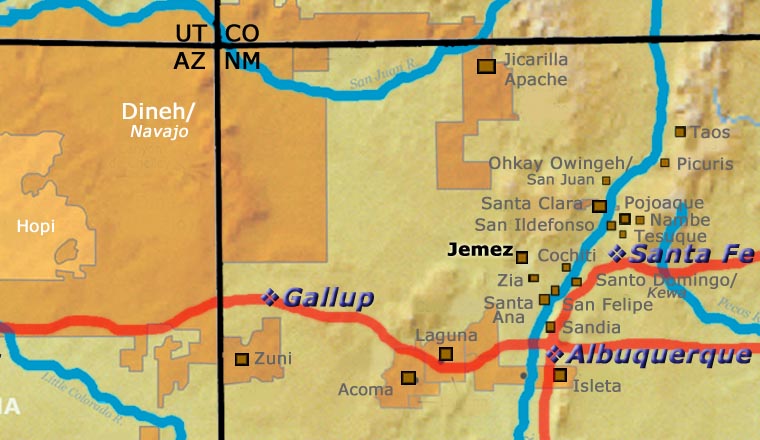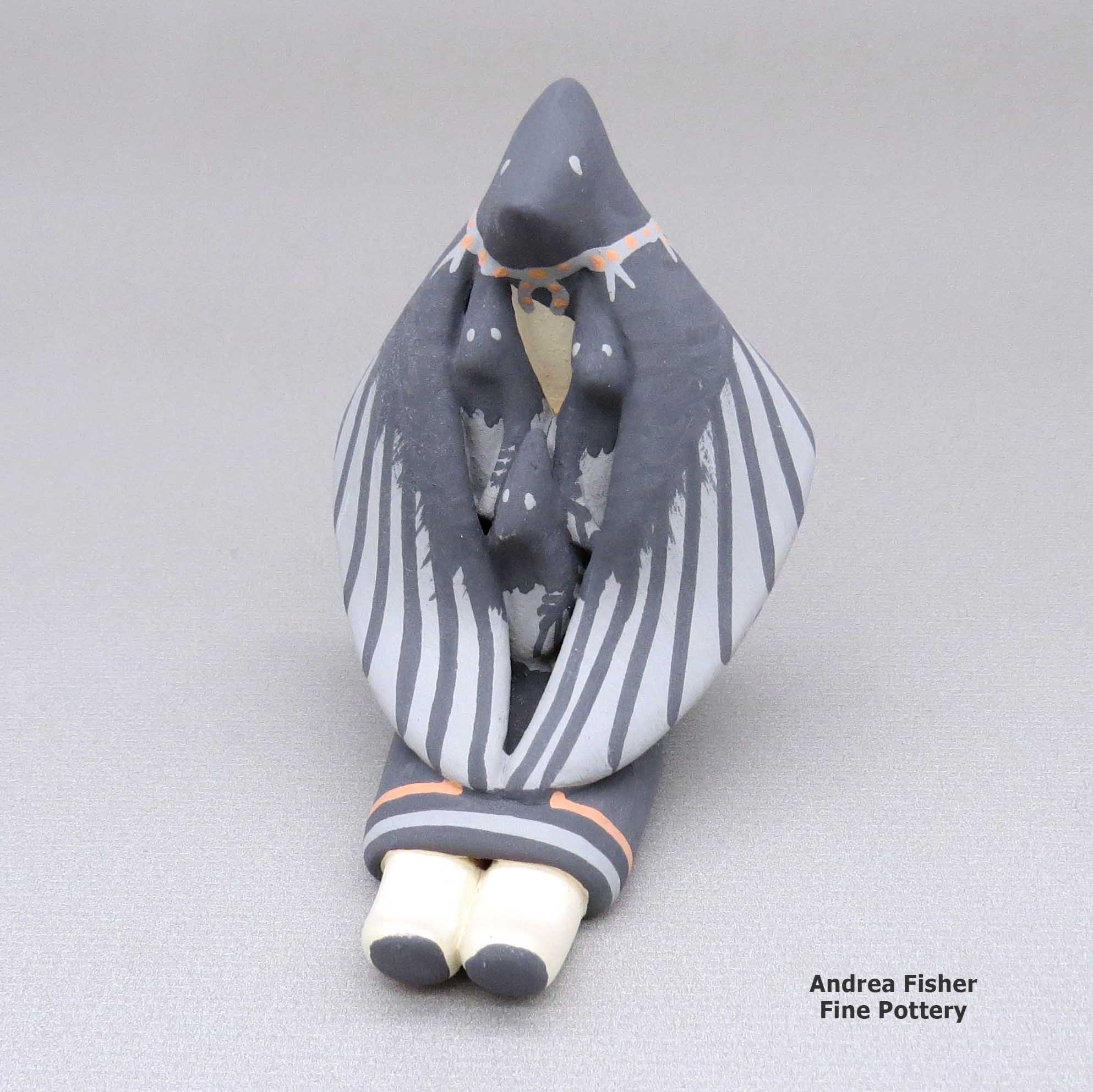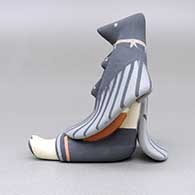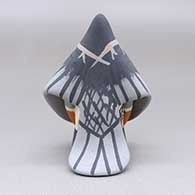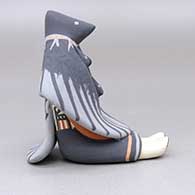
Loren Wallowing Bull
Jemez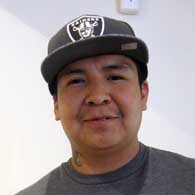
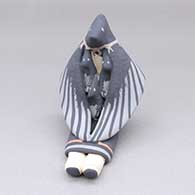
Loren Wallowing Bull was born in April of 1988 and was raised by Linda Lucero Fragua and Phillip Fragua. He showed an interest in working with clay early in life and his mother (Felicia Curley) began teaching him the Jemez traditional way when he was about five years old. So like others of his generation in the Fragua family (Chrislyn, Amy, Anissa and Clifford), his feel for the clay goes way back.
Loren has participated in shows at the Heard Museum in Phoenix, Eight Northern Pueblos Arts and Crafts Show, Tucson Art Museum and the Santa Fe Indian Market. At Santa Fe he earned a First Place ribbon in the Youth Pottery Division and he's earned a First Place ribbon at the Eight Northern Indian Pueblos Arts and Crafts Show.
Loren tells us he gets his inspiration from his family and, like them, he truly enjoys making pottery. His favorite shapes are eagles, as storyteller figures and in nativity scenes. He also says he likes to push the style envelope and come up with something new, something different. That's how he came up with his eagle nacimientos and now he can't make enough of them.
100 West San Francisco Street, Santa Fe, New Mexico 87501
(505) 986-1234 - www.andreafisherpottery.com - All Rights Reserved

Jemez Pueblo

Ruins of San Jose de las Jemez Mission
As the drought in the Four Corners region deepened in the late 1200's, several clans of Towa-speaking people migrated southeastward to the Canyon de San Diego area in the southern Jemez mountains. Other clans of Towa-speaking people migrated southwest and settled in the Jeddito Wash area in northeastern Arizona, below Antelope Mesa and southeast of Hopi First Mesa. The migrations began around 1275 and were mostly complete by 1350.
Archaeologist Jesse Walter Fewkes argues that pot shards found in the vicinity of the ruin at Sikyátki (near the foot of Hopi First Mesa) speak to the strong influence of earlier Towa-speaking potters on what became "Sikyátki Polychrome" pottery (Sikyátki was a village at the foot of First Mesa, destroyed before the first Hopi contact with the Spanish in 1540). Fewkes maintained that Sikyátki Polychrome pottery is the finest ceramic ware ever made in prehistoric North America.
Francisco de Coronado and his men arrived in the Jemez Mountains of Nuevo Mexico in 1539. By then the Jemez people had built several large masonry villages among the canyons and on some high ridges in the area. Their population was estimated at about 30,000 and they were among the largest and most powerful tribes in Northern New Mexico. Some of their pueblos reached five stories high and contained as many as 3,000 rooms.
Because of the nature of the landscape they inhabited, farming was very hard. So the Jemez became traders, too, and their people traded goods all over the Southwest and northern Mexico.
The arrival of the Spanish was disastrous for the Jemez and they resisted the Spanish with all their might. That led to many atrocities against the tribe until they rose up in the Pueblo Revolt of 1680 and evicted the Spanish from northern New Mexico. With the Spanish gone, the Jemez destroyed much of what they had built on Jemez land. Then they concentrated on preparing themselves for the eventual return of the hated priests and the Spanish military.
The Spanish returned in 1692 and their efforts to retake northern New Mexico bogged down as the Jemez fought them doggedly for four years. In 1696 many Jemez came together, killed a Franciscan missionary and then fled to join their distant relatives in the Jeddito Wash area. They remained at Jeddito Wash for several years before returning to the Jemez Mountains. As a result of that long ago contact, there are still strong ties between the Jemez and their cousins on Navajo territory at Jeddito. On their return to the Jemez Mountains, the people built the pueblo they now live in (Walatowa: The Place) and made peace with the Spanish government.
Some of the Jemez people had been making a type of plainware pottery (simple, undecorated, utilitarian) when they were still in the Four Corners area, while others had developed a distinctive type of black-on-white pottery. In moving to the Jemez Mountains, they brought their knowledge and techniques with them but had to adapt to the different materials available to work with. Over time, the Jemez got better in their agricultural practices and began trading agricultural goods to the people of Zia Pueblo in return for pottery. By the mid-1700's, the Jemez were producing almost no pottery.
East of what is now Santa Fe is where the ruins of Pecos Pueblo are found. Pecos Pueblo was a large pueblo housing up to 2,000 people at its height. The people of Pecos and the Galisteo Basin were the only other speakers of the Towa language in New Mexico and when that area fell on increasingly hard times (Apache and Comanche raids, European diseases, drought), Pecos was finally abandoned in 1838 when the last 17 residents moved to Jemez. The Governor of Jemez welcomed them and allowed them to retain many of their Pecos tribal offices (governorship and all). Members of former Pecos families still return to the site of Pecos Pueblo every year to perform religious ceremonies in honor of their ancestors.
When general American interest in Puebloan pottery started to take off in the 1960's, the people of Jemez sought to recover that lost heritage. Today, the practice of traditional pottery-making is very much alive and well among the Jemez.
The focus of Jemez pottery today has turned to the making of storytellers, an art form that now accounts for more than half of their pottery production. Storytellers are usually grandparent figures with the figures of children attached to their bodies. The grandparents are pictured orally passing tribal songs and histories to their descendants. While this visual representation was first created at Cochiti Pueblo (a site in close geographical proximity to Jemez Pueblo) in the early 1960's by Helen Cordero, it speaks to the relationship between grandparents and grandchildren of every culture.
The pottery vessels made at Jemez Pueblo today are no longer black-on-white. Instead, the potters have adopted many colors, styles and techniques from other pueblos to the point where Jemez potters no longer have one distinct style of their own beyond that which stems naturally from the materials they themselves acquire from their surroundings: it doesn't matter what the shape or design is, the clay says uniquely "Jemez."
100 West San Francisco Street, Santa Fe, New Mexico 87501
(505) 986-1234 - www.andreafisherpottery.com - All Rights Reserved

Jemez
$ SOLD
zzje3d121m3
Polychrome raven storyteller with three chicks
3 in L by 2.25 in W by 3.25 in H
Condition: Excellent
Signature: Loren Wallowing Bull Jemez
Date Created: 2023
100 West San Francisco Street, Santa Fe, New Mexico 87501
(505) 986-1234 - www.andreafisherpottery.com - All Rights Reserved

Storytellers
Pueblos: Cochiti, Jemez, Acoma, Isleta, Santa Clara
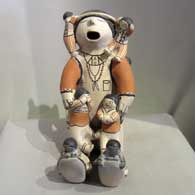
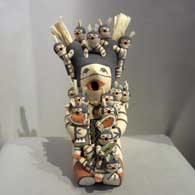

Historically, clay figures have been present in the Pueblo pottery tradition for most of the last thousand years. However, figures and effigies were denounced as "works of the devil" by the Spanish missionaries in New Mexico between 1540 and 1820. Before and after that time the art of making figurative sculpture flourished, especially at Cochiti Pueblo. The forms of animals, birds and caricatures of outsiders and, more recently, of images of mothers and grandfathers telling stories and singing to children have multiplied.
The "storyteller" is an important role in the tribe as parents are often too busy working and raising kids to pass on their tribal histories and the Native American people did not have a written language to record anything for posterity. The closest thing they had to a written language was pottery and the designs that decorated that pottery. So the storyteller's role was to preserve and retell and pass down the oral history of his people. In most tribes that role was fulfilled by men.
The first real storyteller figure was created in 1964 by Cochiti Pueblo potter Helen Cordero in memory of her grandfather, Santiago Quintana. She gathered her clay from a secret sacred place on the lands of her pueblo. Then she hand-coiled, hand painted and fired that first storyteller figure the traditional way: in the ground. Helen never used any molds or kilns to make her pottery.
Helen's creation struck a chord throughout all the pueblos as the storyteller is a figure central to all their societies. Most tribes also have the figure of the Singing Maiden in their pantheon and in many cases, the mix of Singing Maiden and Storyteller has blurred some lines in the pottery world. Today, as many as three hundred potters in thirteen pueblos have created storytellers, and their storytellers are not only men and women, but also Santa's, mudheads, koshares, bears, owls and other animals, sometimes encumbered with children numbering more than one hundred! Each potter has also customized their storyteller figures to more closely reflect the styles and dress of their own tribes, sometimes even of their own clans.
100 West San Francisco Street, Santa Fe, New Mexico 87501
(505) 986-1234 - www.andreafisherpottery.com - All Rights Reserved

Emilia Loretto Family Tree
Disclaimer: This "family tree" is a best effort on our part to determine who the potters are in this family and arrange them in a generational order. The general information available is questionable so we have tried to show each of these diagrams to living members of each family to get their input and approval, too. This diagram is subject to change should we get better info.
- Emilia Loretto (c. 1910s-) & Carmalito Loretto
- Grace L. Fragua (c. 1920s-) & Felix Fragua
- Bonnie Fragua (1966-)
- Jonathan Fragua (c. 1985-)
- Caroline Fragua Gachupin & Joseph R. Gachupin Sr.
- Joseph E. Gachupin Jr.
- Cindy Fragua (1963-)
- Clifford Kim Fragua (1957-)
- Felicia Fragua (1964-) & Mike J. Curley
- Ardina Fragua (1980-)
- Loren Wallowing Bull (1988-)
- Linda Lucero Fragua and Phillip M. Fragua
- Chrislyn Fragua (1973-)
- Anissa Fragua
- Chrislyn Fragua (1973-)
- Rose Fragua (1946-)
- Janeth Fragua (1964-)
- Emily Fragua Tsosie (1951-2021) & Leonard Tsosie (1941-)
- Darrick Tsosie (1977-)
- Joseph L. Tsosie (c. 1970s-)
- Lorna Tsosie (c. 1970s-)
- Robert Tsosie (c. 1970s-)
- Bonnie Fragua (1966-)
- Angela Loretto
- Anthony Loretto (1969-)
Some of the above info is drawn from Southern Pueblo Pottery, 2000 Artist Biographies, by Gregory Schaaf, © 2002, Center for Indigenous Arts & Studies
Other info is derived from personal contacts with family members and through interminable searches of the Internet and cross-examination of the data found.
(505) 986-1234 - www.andreafisherpottery.com - All Rights Reserved
